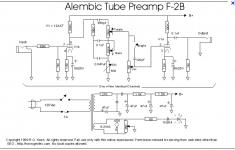Hi
I need advices about a Guitar Bass Preamp Project :

It's not a preamp into the guitar bass project
-1- Tubes ,Op amp or Transistors
-2- Kit ,DIY ,Commercial
-3- Examples
S-PRE - London Power Spectum Bass Preamp Kit
Alembic tube preamp F2B ( pictures )
Thanks
Serge
I need advices about a Guitar Bass Preamp Project :


It's not a preamp into the guitar bass project
-1- Tubes ,Op amp or Transistors
-2- Kit ,DIY ,Commercial
-3- Examples
S-PRE - London Power Spectum Bass Preamp Kit
Alembic tube preamp F2B ( pictures )
Thanks
Serge
Attachments
Your question is not clear.
Please detail what you need or want to do.



I would like a bass preamp to be connected to my Headphone AMP.
I would like a "pure" sound with no saturation .
I am interested by a tube preamp project like this one S-PRE - London Power Spectum Bass Preamp Kit
In fact i have no precise idea 🙂
Serge
Here are a couple of threads that may interest you,
http://www.diyaudio.com/forums/instruments-amps/235915-bass-pre-amp-di-output.html#post3489196
http://www.diyaudio.com/forums/inst...ed-direct-output-di-bass-amp.html#post2883491
jer 🙂
http://www.diyaudio.com/forums/instruments-amps/235915-bass-pre-amp-di-output.html#post3489196
http://www.diyaudio.com/forums/inst...ed-direct-output-di-bass-amp.html#post2883491
jer 🙂
If you're looking for clean sound it doesn't matter much whether you use tubes or solid state. And tubes complicate the power supply, requiring a slightly special transformer, and take more effort to make the chassis. They also run hot enough that if you touch the box, you can burn yourself.
Against that, they do sound very nice. But a transistor or op-amp can sound pretty good, too, with a lower output impedance (100kΩ will make it sensitive to the output cable), smaller, lighter, cooler. And with more flexibility on equalisation, maybe, for use with phones, a touch of compression to stop it blowing your eardrums. The circuit you've suggested looks quite nice, though I can't judge the tone controls without building one - only thing I might do is add an input capacitor so any source with a DC offset (like a stomp box) would not upset the biasing. Oh, and being me, change the input resistor to 3M3, instead of one megohm. (I'm a fanatic for high input impedances on basses).
Translation follows
Si vous cherchez un son sans saturation, ça change peu si vous choissisez lampes ou transistors, sauve que les lampes chauffent plus, sont plus lourdes, et l'alimentation est plus compllqué, demandant un transformateur spécial. En échange, ça sonne très bien.
Mais une circuit transistor peut sonner bien aussi, en plus compact, légère et avec possibilité dans le même boitier d'avoir plus de gamme d'égalisateur et peut-être, pour les casques, un minimum de compression pour ne pas péter les oreilles.
Je ne sais pas que est que c'est l'entrée de votre preampli casques - certains sont assez bas impédance, prévus pour travailler sur le sortie d'un ordinateur ou iPod. Tout façon, si vous le fabriqués vous même, c'est une bonne idée de rajouter une sortie bas impédance symmétrique avec interrupteur de masse, un DI, pour entrer dans les consoles d'enregistrement ou sonorisation. 🙂
Against that, they do sound very nice. But a transistor or op-amp can sound pretty good, too, with a lower output impedance (100kΩ will make it sensitive to the output cable), smaller, lighter, cooler. And with more flexibility on equalisation, maybe, for use with phones, a touch of compression to stop it blowing your eardrums. The circuit you've suggested looks quite nice, though I can't judge the tone controls without building one - only thing I might do is add an input capacitor so any source with a DC offset (like a stomp box) would not upset the biasing. Oh, and being me, change the input resistor to 3M3, instead of one megohm. (I'm a fanatic for high input impedances on basses).
Translation follows
Si vous cherchez un son sans saturation, ça change peu si vous choissisez lampes ou transistors, sauve que les lampes chauffent plus, sont plus lourdes, et l'alimentation est plus compllqué, demandant un transformateur spécial. En échange, ça sonne très bien.
Mais une circuit transistor peut sonner bien aussi, en plus compact, légère et avec possibilité dans le même boitier d'avoir plus de gamme d'égalisateur et peut-être, pour les casques, un minimum de compression pour ne pas péter les oreilles.
Je ne sais pas que est que c'est l'entrée de votre preampli casques - certains sont assez bas impédance, prévus pour travailler sur le sortie d'un ordinateur ou iPod. Tout façon, si vous le fabriqués vous même, c'est une bonne idée de rajouter une sortie bas impédance symmétrique avec interrupteur de masse, un DI, pour entrer dans les consoles d'enregistrement ou sonorisation. 🙂
Buffer + gain stage + drive + blend + eq + compressor ...find a (old) amp you like, and find his shematic...?
- Status
- Not open for further replies.
- Home
- Live Sound
- Instruments and Amps
- Guitar Bass Preamp Project
